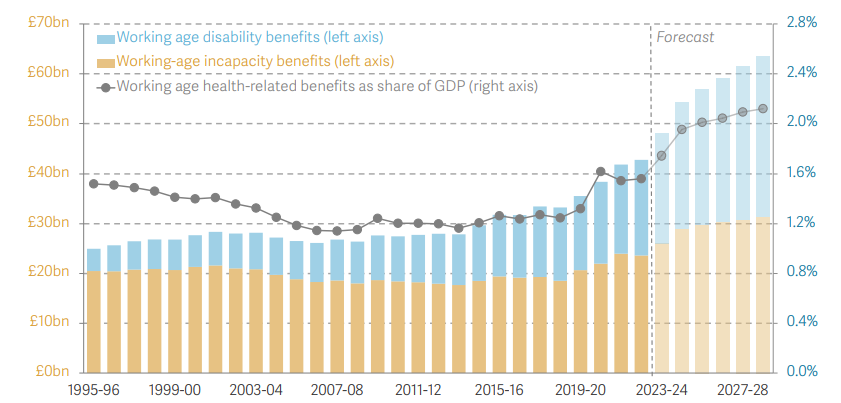20 June, 2024 Open access
20 June, 2024 Open access
Resolution Foundation also warns that curbing the £20 billion a year rise in spending expected by 2028/2029 must be a task for the NHS and employers, not just the Treasury and DWP
Any policy change that limits the increasing number of working-age health-related benefit claims without understanding the underlying drivers of the trend is ‘risky in the extreme’, the Resolution Foundation has warned.
In an election briefing note, that also forms part of a new research programme, the Resolution Foundation investigates trends in working-age disability and ill-health benefits making the key observation that spending on the two benefit types has risen by £15 billion (from £28 billion to £43 billion per year) in the decade to 2022/2023 (based on 2024/2025 prices) and is expected to increase further over the next six years to £63 billion.
Real-terms spending on working-age health-related benefits
and working-age health-related benefits as a proportion of GDP in Great Britain

In addition, the report identifies that the factors that are driving the increased caseload include that -
The Resolution Foundation adds that increased spending is also being driven by a 21 per cent increase in average PIP awards over the last decade, noting that this is set to rise by a further 7 per cent by 2028/2029. Identifying policy design as one explanation for this trend, the report highlights PIP features including -
Placing its findings in the political context, the Resolution Foundation highlights some of the health-related benefit policy proposals from the Conservatives in recent years – including in the Health and Disability White Paper and the Modernising support for independent living’ Green Paper, and their Election 2024 manifesto commitment to cut £12 billion a year from the benefits bill by the end of the next Parliament - together with the Labour Party manifesto commitment to review the work capability assessment.
Concluding its analysis, the Resolution Foundation suggests that there are three lessons to be borne in mind by whoever forms the next government -
'First, policymakers must advance cautiously given the financial insecurity of so many of those who stand to be affected by any change … disability benefits do a good job of protecting incomes, even if they do not fully capture the extra costs of disability ...
Second, the next government should seek to understand why there are 2.9 million more disabled working-age adults in Britain than there was a decade ago. How much of this trend relates to worsening population health, for example; a changing understanding of disability; cuts to the NHS and wider public services; or the changing world of work? It is highly likely that any policy response to rising working-age health-related benefit claims will extend past the benefits system, and also include action focused on the education system, the world of work, public services and beyond.
Third, it is important to learn from the past, and seek to design a benefits system that does not create more problems than it solves. The fact that over the last fifteen years, the share of GDP spent on all working-age benefits has barely changed, standing at 3.9 per cent in both 2007-08 (on the eve of the financial crisis - a better baseline than 2010/2011) and in 2022/2023 suggests that policymakers have inadvertently been playing 'Whack-aMole' in this area: where standard rates of working-age benefits have been hit, some of that pressure has shown up as rising claims for health-related benefits which they then try to hit in response. This is not a strategy for future success.'
For more information, see Under strain: Investigating trends in working-age disability and incapacity benefits from resolutionfoundation.org
#election2024 #manifesto
Our webtools: